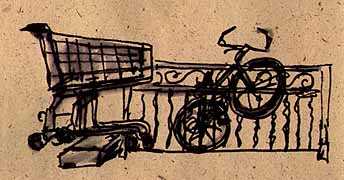American Sabbatical 88: 4/8/97
Ocmulgee
4/8.. Ocmulgee.
Shuttling across the timeline we’d lost two hours, and found ourselves back in the Atlantic
watershed late in the morning. Somewhere between the Chattahoochee
and the Ocmulgee we returned to an eastern drainage. We have one
more site to visit on this slope before we climb into the Georgia
highlands: Ocmulgee Mounds.
It was a short hop over the outskirts of Macon to the park, and
into prehistory. History, too. William Bartram has visited this
place when there was a trading post and Indian village here, and
recorded his observations on the big mounds. |
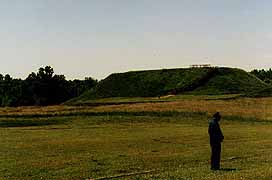
A Sense of Scale
|

Ocmulgee Coon
|
The traces of passage get thick and overlain here. We’ve zagged
across DeSoto’s and Bartram’s trails in Alabama and now in Georgia.
And their stories remind us that traders and drovers were the
true European pioneers in the South (and across most of the continent).
Itinerant peddlers, French, Spanish, and Anglo.. and all the mixtures..
were granted safe passage across hostile territories because of
the goods they could provide. They penetrated the far corners
of the so-called unknown wilderness long before settlers claimed
such places as “frontier.” Bartram traveled in the company of
horse and merchandise traders, who warned him of zones of conflict
and coached him in native hospitality. Ocmulgee was a post in
the chain of commerce. |
| Hunters and miners fanned out behind the traders, and drovers
pushed their herds across the Georgia savannas well in advance
of immigrant farmers. The rich pasturelands we’ve been admiring
in North Florida, Alabama and Georgia were magnets for horse breeders,
who would turn remudas loose and negotiate with the Indians over
the offspring. DeSoto himself, while remembered as a breastplated
warrior-explorer, actually drove a herd of swine along with him,
and the increase was so prolific that it provided the genesis
of wild pigs across the region. |

Cat Pottery
|
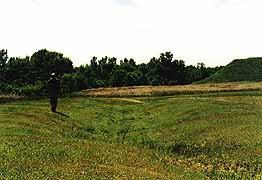
Mythic Traveler
|
The drovers of the South were a significant stream in the cowboy
tradition, and a lot of them were black.. escaped slaves and freedmen
who migrated ahead of settlements, were a part of the history
of the civilized tribes, and were eventually absorbed in the great
cowboy story of the high plains. Woodland drovers tended not to
be horsemen, though, that was a Spanish style from New Spain.
The classic cowboy of lore is a Spanish-Southern offspring. Guess
I’m arguing that DeSoto was the first cowboy. How did I get into
that corner?
|
| Long before Spanish pigs galloped through Georgia, however, there
was a high civilization here, piling up pyramids of earth. Ocmulgee
was another ceremonial and settlement center at the time of Cahokia,
and some of the charge we felt in East St. Louis still radiates
here. Although fewer in number, and smaller in size, the Ocmulgee
Mounds are in some ways more visually dramatic. They rise up framed
by aisles of tall oaks and pines and other hardwoods. Where the
mounds covered a vast acreage at Cahokia and the impact is of
a vanished city, here you are pushed up close to the bases of
the pyramids and their vertical inspiration lifts you. |
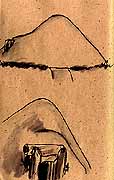
Earth Lodge
|
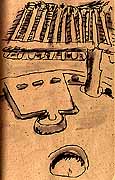
Inside Lodge
|
The most gripping experience here is underground, however. A recreated
earth lodge sits atop a dramatic height. Entering along the low-ceiling
post and mat-lined passage you come into a glass-walled viewing
chamber. Around you, enclosing the original excavated floor, is
a conical pole and mat roof, on top of which the earth is mounded.
The archtypal initiatory environment. A ritual space.
Sketching in the claustrophobic space, my imagination began to
fill the 50 ritual seats around the perimeter, and I moved into
an other time. Coming out into the bright light and the music
of songbirds was a bit of simple magic. I opened out. And wandered
among the other mounds, drawing and painting. There are no overwhelming
images here.. slopes and lawns and big trees.. but I felt grounded.
It was mid afternoon before Peggy could lure me away. |
(Memo #82)
April 8 Ocmulgee Mounds
Who? Prehistoric people of central Georgia and their successors
What? mounds, village, trading post site
When? 10,000 years of occupations
Where? mound site on small river in central georgia
How? hunter-gatherers became sedentary farmers, explorers come,
then traders
Topics: prehistory, mound sites, Mississippian culture
Questions: How does our view of prehistory in North America reflect
the reality? Who were the Moundbuilders? |
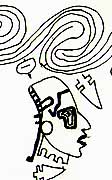
Ocmulgee Details
|
Ocmulgee, on the Macon plateau of central Georgia, has been inhabited
for about ten thousand years. Nomadic hunters came first, followed
by agricultural villagers, then the townspeople of the chiefdoms
building huge earthen mountains (the word “mound” just seems inadequate),
then the tribes first contacted by whites. Once again the archaeological
records and incredible structures challenge the idea that Europeans
“settled”, “discovered’, or “civilized” the Americas.

Great Mound
Seeing Ocmulgee in A.D.1791, naturalist William Bartram commented:
“ On the heights of these low grounds are yet visible monuments
of an ancient town...very wonderful remains of the power and grandeur
of this part of America.”
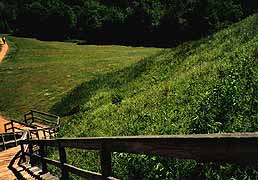
Looking Down Mound
|
New World prehistory is divided by archaeologists into a series
of eras based on the subsistence patterns and technology of the
people. The first is the PaleoIndian Period (pre 9000 B.C., people
were nomadic hunter-gatherers focusing on big game), Archaic Period
(9000-1000 B.C., smaller game animals, appearance of pottery),
Woodland Period (1000 B.C.-A.D.900, first agriculture, semi-permanent
settlements, mounds for burials), Early Mississippian Period (A.D.900-1100,
a people that spread from the Mississippi Valley, more crops,
true towns, huge mounds, chiefdoms, stratified societies), Late
Mississippian-Lamar (A.D.1350-c.1690, the palisaded towns and
temple mounds of OCMULGEE, the people that DeSoto visited in the
southeast in the early 1540’s), Historic Period (c.A.D. 1690-1715).
|
At Ocmulgee we saw prehistoric mounds, and later village and trading
post remains in a pretty natural setting with woods around the
large grassy clearings. The small museum and car park are hidden.
True, there was still modern roadway noise and you could see Macon
from the top of the great mound, but we got a sense of the landscape
when the villagers were here.

Entrance View of Earth Lodge
The museum at Ocmulgee is set so that you see the first mounds
through a long window. The nearest is not a ritual mound at all,
but a turf covered ceremonial building (huge earth lodge) over
1000 years old, one of eight excavated on the plateau. The reconstructed
inner chamber (a 42 foot circular chamber reached by a long low
hallway walled in mats) has a central firepit, a raised earthen
platform shaped like a bird. It is dim and hushed on a bright
day. This was part of a palisaded village. A short walk down and
up a gully brings you to the next plateau where the remains of
a 1690’s trading post and earlier mounds are located. The pentagonal
trading post was built by traders from Charleston who got deerskins
from the Creeks in exchange for a variety of goods (tools, weapons,
textiles).The site was finally abandoned in about A.D.1715.
| Several hundred yards away is the large temple mound, a grasscovered
earthen hill 45 feet high with a 300 foot by 270 foot base. It
was constructed in several stages to its full height (which required
an estimate MILLION basketloads of dirt to construct.). Buildings
were constructed on top. Though less than half the size of the
great mound at Cahokia it is imposing. Not far away is a smaller
funeral mound which contained over 100 burials. |
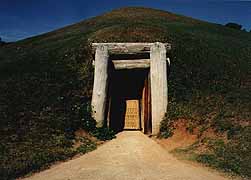
Going Underhill
|
The museum contained a wide variety of artifacts from the ten
thousand years of history. It’s hard to take in so much (think
of a museum trying to cover Neanderthal to today’s Paris!!!).
Still, we are getting a good sense of the Mississippian peoples
whose combination of large palisaded villages, stratified society,
huge earth mounds, efficient agriculture we’ve seen at Cahokia,
Lake Jackson and will see tomorrow at Etowah.

Backside of the Great Mound
4/8.. contd.
Into the roaring 20th century. We’ve been dodging the corridors of commerce and
the cities of the New South, but our next target was the Cherokee
homelands, and the way leads through Atlanta. We put on our flight
helmets and rocketed into the fast lane. Back into anywhere USA.
License plates from Florida and Minnesota, Indiana and Illinois.
Snowbirds flocking north in their geezermobiles. Big rigs hauling
the lifeblood of our economy. A tractor pulling a wideload log
cabin breathed down our necks. We’re doing 75 and the traffic
is blowing by us.
|
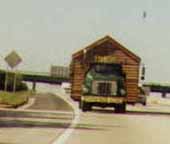
|
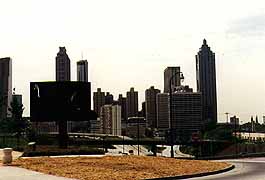
Atlanta
|
The shock of modernity ebbed into familiarity. Again I wondered
if this automoted blight isn’t an unsuspected blessing. Just as
suburban sprawl has sometimes drawn the heat of development away
from pedestrian human-scale downtowns, funneling all this through
traffic into these soul-dead highways has freed the backroads
for unalienated wandering. We’ve huddled up against the through
ways by night, where the chain motels cluster, and it’s been weird
to sleep by the roaring venturi after ambling through rural backwaters.
But it means that places like Plains, and Bowdoinham, can still
survive. |
| We off-ramped into the big A, thinking about counting coup on
the CocaCola Museum, maybe an art gallery or two. But it was gridlock
downtown, and the Owl’s temperature started to rise. Mine too,
I confess. And parking was a nada. We circled the heart of town
a couple times, checking out the street action. All the urban
hustles, to a rap beat and a hi-decibel bellowing. There seems
to be more public shouting down here, or does the overpowering
vibrato of New York drown out the Hey Yous? |
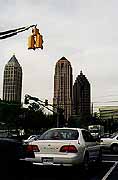
Lanta
|
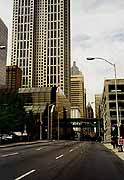
Downtown
|
The buildings in Atlanta are glorious. Soaring sequences of cloud-tickling
bravado, one behind the other. Absurd post-modernist detailing
in gilt, and glittering mirrorwalls. American vertical cities
make you feel elevated just rubbernecking around in them. Lots
of sidewalk cafe action. Everyone in shirtsleeves. And totally
integrated.
We decided not to integrate ourselves, and eventually found our
way back onto the interstate. I felt somewhat guilty for not having
dined on Atlanta. Gone to a Braves game or something cultural
like that. But we were a couple of pooched puppies. Peggy has
been cranking out two memos a day, and we’ve been eating up the
miles. We found another cheap bedroom and called it a day. Going
to look for a campsite in the foothills tomorrow and get some
woodsy R&R. |
| We did go out to sup at a nearby sport’s bar, knowing the cuisine
would be elegant. We weren’t disappointed. The multiscreen ESPN
ambiance was heightened by the choice between hockey or the Braves,
and the walls of Mr. Bimbo’s (we couldn’t resist) were encrusted
with memorabilia, from 3X4foot photos of Mo, Larry and Curly,
and Babe Ruth, to license plates from all over, including an American-flag-tied-with-a-yellow-ribbon
plate. I mean classy. The bouncing blond bimbos in hip-huggers
waiting tables were obviously making the boys thirsty. They were
sucking down the suds. Sophisticated beverages, too. Bud and Coors
on tap. The bar crowd was just as integrated as the ball teams,
slapping fives. If there’s a dark simmering racism down here,
they must be cooling it with beer. This is probably old news to
you Southerners, but we’ve been well over the northern horizon
for 30 years, and it’s good news to us. |
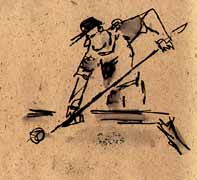
|
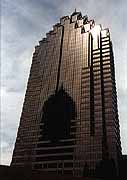
Reflections
|
While I’ve been typing this, Peggy has been surfing the boobtube.
The hot news in Atlanta tonight is that they won’t close all the
turnpike exits for Freaknik Week this year. Apparently that’s
what they call Black College Spring Break, when black students
flock to Atlanta instead of Lauderdale. The black female chief
of police (!) was on, saying that shutting off downtown hadn’t
worked in the past , and they were going to try new traffic control
measures this year. Another image of the New South. Students converging
on a city for a hoorah. Think we’ll just keep moving.
|
